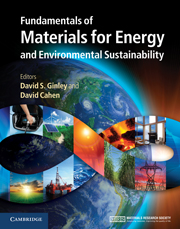Book contents
- Frontmatter
- Contents
- Contributors
- Preface
- Acknowledgments
- Part 1 Energy and the environment: the global landscape
- Part 2 Nonrenewable energy sources
- 9 Petroleum and natural gas
- 10 Advancing coal conversion technologies: materials challenges
- 11 Oil shale and tar sands
- 12 Unconventional energy sources: gas hydrates
- 13 Nuclear energy: current and future schemes
- 14 Nuclear non-proliferation
- 15 Nuclear-waste management and disposal
- 16 Material requirements for controlled nuclear fusion
- Part 3 Renewable energy sources
- Part 4 Transportation
- Part 5 Energy efficiency
- Part 6 Energy storage, high-penetration renewables, and grid stabilization
- Summary
- Appendix A Thermodynamics
- Appendix B Electrochemistry
- Appendix C Units
- Index
- References
16 - Material requirements for controlled nuclear fusion
from Part 2 - Nonrenewable energy sources
Published online by Cambridge University Press: 05 June 2012
- Frontmatter
- Contents
- Contributors
- Preface
- Acknowledgments
- Part 1 Energy and the environment: the global landscape
- Part 2 Nonrenewable energy sources
- 9 Petroleum and natural gas
- 10 Advancing coal conversion technologies: materials challenges
- 11 Oil shale and tar sands
- 12 Unconventional energy sources: gas hydrates
- 13 Nuclear energy: current and future schemes
- 14 Nuclear non-proliferation
- 15 Nuclear-waste management and disposal
- 16 Material requirements for controlled nuclear fusion
- Part 3 Renewable energy sources
- Part 4 Transportation
- Part 5 Energy efficiency
- Part 6 Energy storage, high-penetration renewables, and grid stabilization
- Summary
- Appendix A Thermodynamics
- Appendix B Electrochemistry
- Appendix C Units
- Index
- References
Summary
Focus
Controlled nuclear fusion has the potential to provide a clean, safe energy source with an essentially limitless supply of fuel, relatively few proliferation concerns (compared with those mentioned in Chapter 14), and substantially fewer of the waste-management concerns discussed in Chapter 15. Large experimental devices currently under construction are intended to demonstrate net fusion energy production, a key technological milestone on the way toward the commercial production of electricity. The economic practicality of energy from fusion processes, however, will still require other significant advances, including in the development of materials that can survive the harsh fusion environment.
Synopsis
The nuclear fusion of light elements is the energy source of the stars. A fusion-based power plant holds the prospect of a nearly limitless fuel source, without the concerns of greenhouse-gas emissions, nuclear proliferation, or serious waste management. While the release of enormous amounts of energy from this process has long been demonstrated in weapons, controlling and harnessing this energy for electricity production constitutes a technologically much more difficult problem. At present, the fusion community is exploring two major approaches to controlled nuclear fusion: magnetic confinement and inertial confinement. In the magnetic fusion energy (MFE) approach, powerful magnetic fields confine low-density hydrogen plasma as it is heated to very high temperatures. In the inertial fusion energy (IFE) approach, tiny pellets of solid hydrogen are compressed to very high densities and temperatures.
- Type
- Chapter
- Information
- Publisher: Cambridge University PressPrint publication year: 2011



